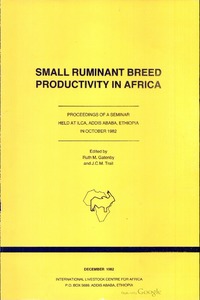Location
Vision, mission and strategy
ILRI's strategy 2013-2022 was approved in December 2012. It emerged from a wide processof consultation and engagement.
ILRI envisions... a world where all people have access to enough food and livelihood options to fulfil their potential.
ILRI’s mission is... to improve food and nutritional security and to reduce poverty in developing countries through research for efficient, safe and sustainable use of livestock—ensuring better lives through livestock.
ILRI’s three strategic objectives are:
- with partners, to develop, test, adapt and promote science-based practices that—being sustainable and scalable—achieve better lives through livestock.
- with partners,to provide compelling scientific evidence in ways that persuade decision-makers—from farms to boardrooms and parliaments—that smarter policies and bigger livestock investments can deliver significant socio-economic, health and environmental dividends to both poor nations and households.
- with partners,to increase capacity among ILRI’s key stakeholders to make better use of livestock science and investments for better lives through livestock.
This is ILRI’s second ten-year strategy. It incorporates a number of changes, many based on learning from the previous strategy (2000–2010, initially produced in 2000 and modified in 2002), an interim strategy (2011–2012) and an assessment of the external and internal environments in which the institute operates.
Members:
Resources
Displaying 1126 - 1130 of 1152The productivity of small ruminants in the Maasai pastoral system, Kajiado District, Kenya. An introduction to current research
Describes the research approach adopted by an interdisciplinary ILCA team to study a pastoralist production system, summarizing the methodology & results of research on small ruminants' productivity in the Maasai pastoral system, and outlining dif. features of current smallstock research in Kenya; w. an analysis of flock productivity, mortality, animal nutrition & behaviour at the Elangata Wuas group ranch.
Small ruminant breed productivity in Africa: Proceedings of a seminar held at Addis Ababa, Ethiopia, October 1982
The Kenyan rangeland ecological monitoring unit (KREMU)
Discusses the Kenya Rangeland Ecological Monitoring Unit (KREMU), mentioning its objectives, initial tasks related to identifying ecological units, testing survey methods, training of staff & designing appropriate computer programmes; describes the Unit's achievements, with emphasis on ecological surveys & censuses carried out within the framework of on-going ecological monitoring programmes; outlines problems encountered.
The aerial survey programme of the Kenya rangeland ecological monitoring unit: 1976-79
Describes the organization, objectives and results of the aerial survey programme of the Kenyan Rangeland Ecological Monitoring Unit from 1976 to 1979, with particular reference to the methodology used, animal population estimates, esp. herbivores, and reliability of aerial survey data in terms of aerial, ground & remote sensing counts.
Low-level aerial survey techniques
Presents workshop papers & discussion summaries on the development of low-level aerial survey techniques and presents applications to livestock, wildlife and land-use surveys. Reviews survey designs and sampling procedures as well as problems of bias, levels, from ground survey to satellite imagery; along w. recommendations for further research and cooperation.




